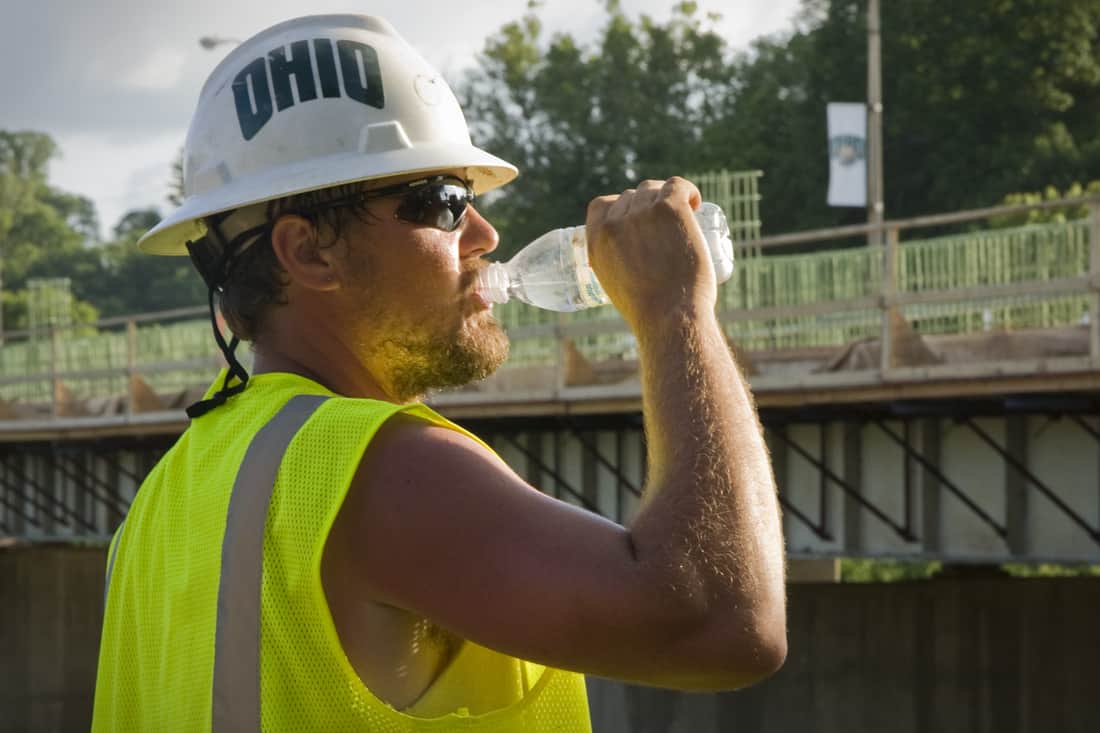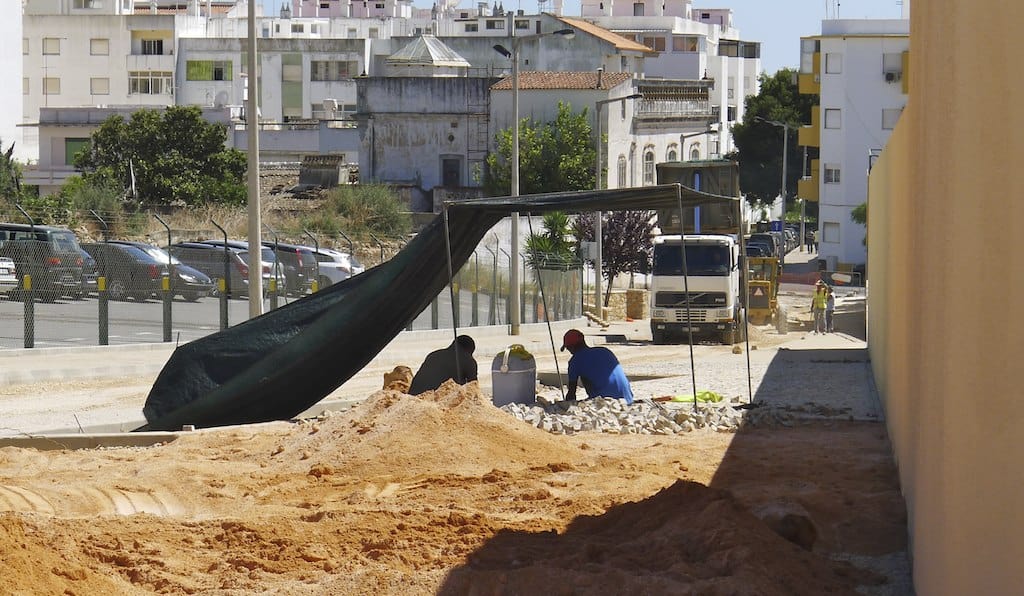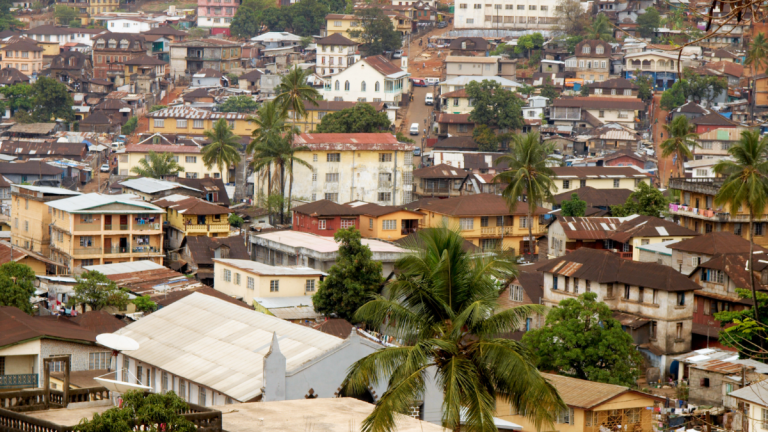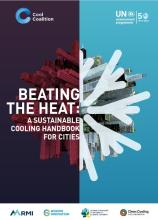Analysis
How Cities can Support Workers in Extreme Heat
Cities can play an important role in ensuring decent conditions for vulnerable workers, protecting them from the effects of extreme heat and promoting the right to healthy and safe workplaces. Here’s how cities can get started.
Photo: Bruno Makori/Pexels
This article originally appeared on C40knowledgehub.org.
Cities around the world are breaking ever more heat records. The first two weeks of July 2023 saw the hottest two-week period ever recorded: Phoenix, Arizona saw temperatures above 43°C (110°F) for 19 consecutive days, China hit a high of 52°C, while Iran recorded a heat index of 67°C, a temperature thought to be intolerable to human and animal life.
Rising temperatures can affect all aspects of daily life, from leisure activities to domestic life to work, and the impacts are especially acute for those who cannot stay indoors or in cool areas during heat waves. They also have a significant economic impact due to lost productivity. The United States loses an average of US$ 100 billion annually from heat-induced declines in labour productivity, for instance, while heat stress is projected to reduce global GDP by US$ 2,400 billion in 2030. Outdoor workers are particularly impacted and increasingly experiencing serious heat-induced illness and death.
Cities can play an important role in ensuring decent conditions for these workers, protecting them from the effects of extreme heat and promoting the right to healthy and safe workplaces. Here’s how cities can get started.
Heatwaves are predictable hazards. Their impacts on people’s health and city infrastructure can be reduced by using simple, cost-effective technologies and strategies. Read how cities can adapt to extreme heat to protect their residents and economies.
Understand who is most impacted in your city and how workers are affected
The workers most impacted by heat will include:
- Groups whose work occurs outside, such as market sellers, rooftop solar panel installers, and transport, forestry, construction and delivery workers. Globally, agricultural and construction workers are expected to be the worst affected, accounting for 60% and 19% of working hours lost to heat stress in 2030, respectively.
- Workers in indoor environments without air conditioning or cooling, such as those in many garment factories.
- Older workers and those with underlying health conditions, who will be more clinically vulnerable (as will children).
- Marginalised workers including migrants, informal labourers and those who have not had access to education, who will be more vulnerable due to socioeconomic factors. Informal or ‘gig economy’ workers often lack the protections afforded to formal workers, including union membership, required breaks or paid time off. Many informal workers will suffer a lack of income on days when it is too hot to work and may feel higher pressure to work in extreme heat conditions. Low-income workers, who are less likely to have access to air conditioning at home overnight, are also more at risk. Outdoor workers typically make up a disproportionate percentage of vulnerable workers.
To identify vulnerable workers, understand their needs and inform strategies to mitigate the adverse effects of high temperatures, cities can conduct a worker-focussed heat vulnerability assessment. Collect, analyse and monitor data on temperature highs, demographics, heat-related illnesses (such as records of hospital admissions and emergency room visits), employment and socioeconomic indicators to highlight patterns and identify industries and groups with greater vulnerability to heat. Geographic information system (GIS) mapping can be used to present data visually, identifying hotspots where impacted workers live and work. Consider partnering with research institutions to analyse data, identify trends and propose evidence-based solutions. Cities should also ensure temperature-related risk assessments are conducted at the workplace level, involving both union health and safety representatives and management.
Cities have the most power to enact protections as employers of heat-vulnerable workers (waste, transport, park workers and so on). As part of the assessment, cities should review who they employ, both directly and indirectly via procurement, that may be affected by heat.
Also collaborate with local health authorities to implement a robust system for collecting and monitoring data related to heat-related illnesses and incidents on an ongoing basis to inform policy and measure the effectiveness of interventions.
Conduct public consultations and engage with stakeholders, including workers, employers, labour unions and advocacy groups, to gather evidence on workers’ needs and concerns and input on proposed changes to labour laws.
Consider appointing a task force, working group or leader focused on heat. Many different city government departments and private stakeholders oversee aspects of heat wave-related preparedness, response and recovery, making a coordinated response challenging. City-led task forces or working groups dedicated to addressing heat-related issues in the workplace can support effective data collection, the formulation and refining of heat protection policies, and the monitoring of impact. Some cities have found that appointing a chief heat officer further supports coordination efforts.
In Santiago, local authorities partnered with the Chilean Security Association (ACHS), an entity representing more than 1 million workers, to promote heat safety measures among outdoor workers. Together, they are educating employers on how to recognise and respond to the dangers of extreme heat. The partnership’s goal is for employers to institute practices to protect their workers and provide health coverage for workers injured on the job. To this end, ACHS is planning to monitor how often workers seek medical care for exposure to extreme heat, which will help inform worker protection policies.

Enact policies requiring employers to protect workers affected by extreme heat
Depending on jurisdiction over labour laws, channels that cities can use to take action include:
- Lead by example and adopt heat protocols for workers employed by the city. Cities can implement policies directly to protect their employees from heat-related issues. This can play a pivotal role in promoting and ensuring the safety of workers from heat-related hazards across supply chains.
- Use procurement power to require heat protections on municipal contracts. Leverage the procurement process to prioritise worker safety from heat-related risks. For example, specify safety standards related to heat protection in procurement contracts, require suppliers to demonstrate compliance with recognised safety certifications and standards related to heat protection (such as those of the Occupational Safety and Health Administration in the US) and conduct regular performance reviews of suppliers. Consider including heat safety performance as a key factor in contract renewals and extensions.
- Introduce incentives such as tax breaks or recognition for businesses and employers who demonstrate commitment to implementing and maintaining effective heat protection policies.
- Amend/enact local labour laws and set local occupational health and safety standards. Develop and enforce laws and regulations that mandate heat protection measures in the workplace, and require periodic reviews of labour laws related to heat protection to ensure they remain aligned with scientific understanding, technological advancements and changing climate conditions. For example, introduce licensing and permitting requirements for businesses, incorporating adherence to heat protection standards as a condition for obtaining and renewing licences, enforced through workplace inspections and other mechanisms for non-compliance.
- Lobby subnational and national governments to enact protections from extreme heat in labour laws. By employing a multifaceted approach that combines research, public awareness, collaboration and direct engagement with policymakers, cities can effectively lobby for labour reforms at both subnational and national level. Cities can form alliances and coalitions with other cities, build relationships with key industry stakeholders who can influence policymakers, front and amplify lobbying efforts, and demonstrate widespread support for labour reforms. Resources from Building Workers International (BWI) offer helpful guidance.
- Launch city-wide public awareness campaigns to educate employers and employees about heat safety in the workplace. Inform the public about their rights and responsibilities as regards heat safety in the workplace and promote a culture of safety in all types of workplace. Read Communicating heat risk for practical advice and city examples.
Using the above mechanisms, cities can enact a combination of policies that:
- Require access to shade, water and personal protective equipment (PPE). Examples include Colorado’s standards for farm workers, Washington state’s Outdoor Heat Exposure Rules and California’s Heat Illness Prevention Standard. These should cover:
- Providing cooling and hydration stations to create designated areas with air conditioning or cooling equipment where employees can take breaks and cool down. Employers should ensure that there are accessible and well-stocked water stations throughout the workplace. Consider policies that encourage the use of mobile water stations, especially in industries with dynamic or changing work locations, to ensure that workers have access to water regardless of their proximity to fixed facilities.
- Requiring shade structures or the provision of shaded areas where employees can take breaks and find relief from the sun, especially for outdoor workers. Define the minimum square footage and proximity to work areas for these shaded spaces.
- Require and provide PPE. Employers should provide appropriate clothing, such as lightweight and breathable uniforms, hats and sunglasses to shield employees from the sun.
- Limit and/or prevent work during specific times.
- Prohibit outdoor work during the hottest hours. Examples include Puglia’s ordinance prohibiting outdoor agricultural work during the hottest days/times. Spain is banning some outdoor work during periods of extreme heat, while Greece has also placed a ban on people working in the construction and delivery sectors during the hottest hours of the day.
- Implement a policy that mandates regular breaks to allow employees to rest and cool down. Require that these breaks be taken in shaded or cool areas.
- Limit and/or outlaw work at and above a specified temperature threshold.
- Establish clear and enforceable maximum temperature limits for outdoor work. These limits should take into account the heat index and other relevant factors. For example, Spain is planning to ban non-essential outdoor work in extreme heat events.
- Develop policies that trigger additional shade and water provisions during periods of extreme heat, heatwaves or other adverse weather conditions. This ensures that protections are heightened when they are needed most.
- Encourage working patterns that adapt to safer temperatures.
- Flexible work schedules allow workers to adjust their work hours to avoid the hottest parts of the day. This may involve starting and ending work earlier or later. Some industries have resorted to working overnight to avoid the heat, however, this can bring other risks due to lower visibility. Policies should cover the occupational risks of night-time work and require adequate lighting and adequate rest periods.
- Require heat training and response protocols for employers and employees impacted by extreme heat. Mandate heat-stress training for employers and employees to educate them on the signs of heat-related illnesses, preventive measures and appropriate responses. For example, California’s heat illness prevention regulation requires all employers to train all employees about heat illness prevention.
- Emergency response protocols: Include detailed protocols for responding to heat-related emergencies. This should cover first-aid procedures, access to medical assistance and transport to medical facilities if needed.
- Employee empowerment: Establish mechanisms that empower employees to report violations or concerns about lack of implementation of health and safety standards and regulations, such as inadequate access to shade and water without fear of retaliation. Ensure confidentiality and non-disclosure of the reporting individual.
- Heat-stress management plans: Require employers to develop and implement heat-stress management plans as part of their occupational health and safety programmes. These plans should outline strategies for providing shade, water and other preventative measures. Sydney has implemented heat-stress management plans for outdoor workers that include provisions for shaded rest areas, scheduled breaks and easy access to water to mitigate the impact of extreme heat.
Temperature thresholds and protocols could be linked to city-wide, city-run heat alert systems and emergency response protocols, such as that used by Santiago. The International Federation of Red Cross and Red Crescent Societies’ Heatwave guide for cities offers advice on establishing these systems.
Santiago’s tiered heat alert system
In a system developed with Chile’s National Service for Disaster Prevention and Response, Santiago uses a tiered system to issue public alerts and implement agreed measures on days forecast to be 24°C (75°F) or higher. For instance, on ‘green alert’ days, authorities disseminate preventative care measures and guidance, while on ‘red alert’ days, they will suspend outdoor activities and prepare public and private healthcare facilities for a possible influx of patients with heat-related illnesses.

Work with business associations, unions and labour organisations to develop industry-specific heat protection guidelines
Conduct industry-specific engagement to understand the needs of and solutions for heat-impacted industries. For example, in the construction industry, policies that prioritise retrofit (which requires less construction), Modern Methods of Construction or clean construction practices (such as modular construction) tend to be safer and less subject to heat exposure than standard construction practices. However, cities should engage with sectors to understand the different risks that alternative working patterns may pose.
Work with businesses, unions and labour organisations to identify needed labour reforms and develop a set of protocols for outdoor workers during extreme temperatures. For example, in Buenos Aires, the City-Business Climate Alliance is working with companies to look at ways to support outdoor workers, including developing a set of protocols for outdoor workers during extreme temperatures. This helps to promote awareness of heat protection measures and encourage voluntary compliance, and recognise and showcase businesses that prioritise worker safety. Cities can also encourage voluntary adoption of these guidelines and provide support for businesses to implement them.
Conduct education programmes for businesses and offer certifications. Cities can work with businesses to develop training programmes for employers and employees focused on heat-stress prevention. Certifications can be offered to those who complete the training successfully, spotlighting businesses that demonstrate excellence in heat protection measures, while recognising and promoting best practices.
Encourage major employers in the city sign up to a good employer charter that includes heat-specific working policies. This can be an option if your city does not have jurisdiction to pass labour laws. For example, London’s Good Work Standard provides employers with a set of best employment practices alongside information and resources to help achieve them. They are organised into four key areas, known as pillars, which are relevant and important to any organisation and employer. The BWI Manifesto for Healthy and Safe Workplaces for migrant workers in Extreme Heat and the Climate Crisis offers another example.
Install heat protection infrastructure and introduce heat-specific workplace design standards
Workplace design standards: Incorporate shade provisions into workplace design standards. Encourage the inclusion of structures such as awnings, pergolas or other shading solutions in the planning and construction of outdoor workspaces.
Urban planning and zoning regulations: Integrate heat protection requirements into zoning regulations, especially for industries that involve outdoor work. Zoning laws can dictate the permissible working conditions based on temperature and other environmental factors. Smart urban planning can help significantly to mitigate heat stress on construction sites.
Require heat sensors or apps to be installed at outdoor work sites and conduct heat-stress monitoring: Monitor on-site weather conditions and use heat-stress monitors to assess environmental conditions and adjust work activities accordingly. In Tokyo, Daiwa House Industry Co Ltd has introduced countermeasures for heatstroke at construction sites. When an excessive heat index is detected, a warning is given to workers and an e-mail is sent to supervisors to help take quick measures and prevent accidents. More information about the sensor, called WEATHERY, can be found here.
Install shade infrastructure and air conditioning for heat-vulnerable workers in city-owned or managed spaces. For example, shading covers over three outdoor markets in Freetown provide sustainable infrastructure that protects market women from the dangers of extreme heat.
Read How to adapt your city to extreme heat and Heat: How to expand your city’s tree canopy cover for more advice on reducing heat risk in the city beyond workplaces.
Establish monitoring and reporting mechanisms
Implement measures for monitoring workers’ health in high-temperature environments, for example:
- Develop mechanisms for monitoring and reporting heat-related incidents or near misses in the workplace. Include clauses that require suppliers to promptly report any incidents and outline consequences for non-compliance. Provide mechanisms to enable workers to report violations or heat-related concerns anonymously. Investigate and address reported issues promptly. Digital reporting platforms can facilitate real-time monitoring and enhance the city’s ability to respond to emerging issues.
- Facilitate the establishment of safety committees or representatives to ensure that workers have the right to voice their concerns about unsafe working conditions, including excessive heat, without fear of retaliation. In the UK, the Safety Representatives and Safety Committees Regulations 1977 provide workers and employers with guidance on the rights, role and functions of worker health and safety representatives.
- Offer legal aid and support services. Establish or enhance legal aid and support services for workers who may face retaliation or discrimination for raising concerns about heat-related issues. Ensure that workers have avenues to seek redress in case of violations.
LEARN MORE

Webinar on Extreme Urban Heat: Opportunities to Mitigate Risks in Cities
In this webinar, UrbanShift and WRI lead a conversation with cities and experts on effective strategies to cool down urban areas.

How Africa’s First Chief Heat Officer is Helping to Create a More Resilient Freetown
As extreme heat rises across the globe, Eugenia Kargbo is showing how cities can prioritize strategies to mitigate risks and support residents' wellbeing.

How Nature Can Help Cities Fend Off Record-Smashing Heat
As recorded temperatures have spiked to new levels this summer, it's more important than ever that cities invest in green to mitigate extreme heat.

Beating the Heat
This handbook was launched at COP26 and provides case studies from cities around the world that demonstrate how to sustainably tackle the urban heat island effect.

